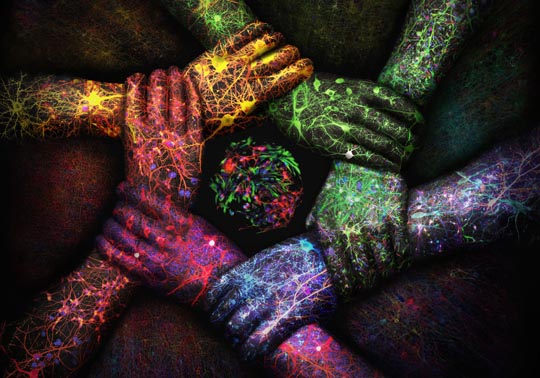Neuroscientific fallas, an opportunity for dissemination
- Scientific Culture and Innovation Unit
- March 14th, 2018

It is difficult to find any activity that is not related to Fallas during the third week of March in Valencia. The Falla Commission Plaza Jesús has combined this festivity with scientific dissemination by focusing the activity of its casal in Neuroscience. Lucía Hipólito and Yolanda Campos, who are researchers of the Faculty of Pharmacy of the Universitat de València, have organised several events. They include a neuromascletà and the presentation of a new fallas application that uses augmented reality.

Fallas 2018 will be again a perfect scenario for the diffusion of art and culture addressed to the general public. Falla Plaza Jesús, alongside with UV researchers Lucía Hipólito and Yolanda Campos, is a pioneer in incorporating scientific dissemination to its programme of activities and its monument for fallas. It is the third time they organize Neuromascletà. It is an event of dissemination which is included in the Brain Week. This themed week is promoted by the Dana Foundation. It is an entity that supports neuroscientific research, the publication of pieces of work, the organisation of seminars and other activities of dissemination. This year project of Falla Plaza Jesús is included in the Brain Week.
As part of the project, Falla Plaza Jesús edits Sinapsis, a particular llibret of fallas that is atypical to a certain extent. The layout recalls the structure of classical scientific magazines, which is unusual in this world heritage festivity. The publication includes a series of articles that are related to neuroscience and brain function. Among others, several professors of the Universitat de València have participated. It is the case of Luis Granero, from the Pharmacy Department (Una qüestió de moral?); Ana Lloret, Physiology Department (Quan comença la malaltia d’Alzheimer?) and Enrique Lanuza, Cell Biology Department (El sentit de l’olfacte, tant vell i (ja no), tant desconegut). Other UV professors such as Juan Nácher, Emilia López, Francisco Grimaldo and Emilio Soria have also written articles.
“Both fallas and researchers have a commitment with society. This is the reason why we think that disseminating science by means of a falla is the perfect way to reach other collectives. The falla is in the streets and it is an element that can bring science to the citizens” highlighted Lucía Hipólito.
The International Brain Week takes places on the third week of March. It is a key date as researchers and disseminators make the most to explain the last studies in neuroscience to the citizenship. The initiative is supported by the Dana Foundation at an international level and by the Federación de Sociedades de Neurociencia (FENS) at a European level. The Sociedad Española de Neurociencia (SENC) is one of the main organizers and coordinators of these activities in Spain. Falla Plaza Jesús has undertaken these activities in Valencia. This project has received an Award of FENS and DANA Foundation worth in €1,000. In addition, the Commission has received the sixth Award of the Premis per la Promoció de l’Ús del Valencià. They were given by the Valencian Department of Education, Research Culture and Sport last Tuesday afternoon.
Neuromascletà
On March 16, Falla Plaza Jesús will offer the third edition of Neuromascletà, short lectures and workshops on neuroscience. They are led by top-tier researchers and professionals. Apart from Lucía Hipólito and Yolanda Campos, other professionals will participate. They are Juan Nácher, professor of the Department Cell Biology, Functional Biology and Physical Anthropology; and Ana Polache, a researcher from the Department of Pharmacy, Pharmaceutical Technology and Parasitology. Laura López from the Cajal-CSIC Institute in Madrid, Nicolás Cuenca from the University of Alacant, Lucía Martí coming from the University of Cambridge, and Carmen Calabuig and Maria Paz Carrión from the ARGOS Physiotherapy Centre.
Augmented reality
In addition, with the aim of showing the role of new technologies in the visualization of scientific dissemination, the University Research Institute on Robotics and Information and Communication Technologies (IRTIC) and the Engineering Technical School of the Universitat de València (ETSE-UV) have collaborated along with the Plaza de Jesús Falla in the development of Synapsis UV-FPJ, the mobile application. It uses augmented reality to interact with the ninot of the Commission, made by the artist Ramón Solaz. It can be visited at the Ninot Exhibition until March 15. Then, it will be set at the Fallero Monument. The ninot symbolises a neuron, which is part of a virtual brain. The user can explore it through the mobile application to obtain information about the latest discoveries on the field of neuroscience.
The llibret, the activities of Falla Plaza Jesús and the development of Synapsis UV-FPJ have been possible thanks to the support of the Chair for Scientific Dissemination of the Universitat de València, the European Societies Federation of Neuroscience, DANA Foundation, the Language Policy Service of Universitat de València and the researching project La Falla Inmaterial.
Captions and gallery of images:
- Sinapsiscover, the llibret of Falla Plaza Jesús
- Neuromascletà poster




















